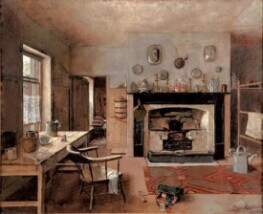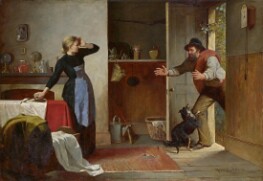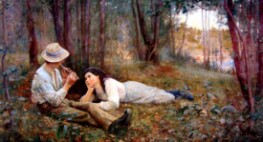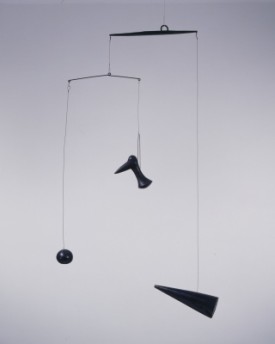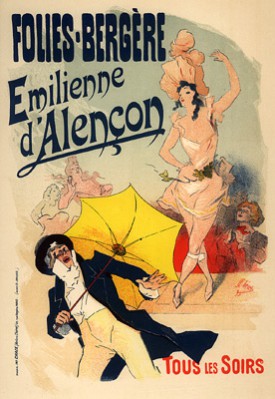The pioneer
The monumental painting, The pioneer (1904) by Frederick McCubbin, is considered one of the greatest masterpieces of Australian art. The artist depicted a pioneering couple in the Australian bush and the progression of their life through three panels. By choosing to paint a triptych, a traditional format used for religious paintings, the artist elevated the status of the pioneers. The choice of subject relates to the rise of Australian nationalism in the years following the Federation of Australia in 1901 (the unification of six separate colonies to the Australian Commonwealth).
The left panel shows the pioneering couple in their new environment: the man in the background is lighting a fire while the woman sitting has a pensive look, thinking of the road ahead. In the central panel, we see the couple a few years later, the woman is holding a baby, and the man is resting on the log. There is evidence of their hard work. Most of the land has been cleared, and a small cottage is seen in the distance. In the right panel, a bushman is kneeling in front of a grave. The developed city in the background indicates that the image is in the distant future, but it remains unclear who the bushman is and to whom the tomb belongs.
The pioneer was painted in the bush near McCubbin’s cottage, which he named ‘Fontainebleau’ as a way of expressing admiration for the French Barbizon School of painting, whose members painted outdoors near the Fountainbleu forest. Like the painters of the Barbizon school, McCubbin painted outside to faithfully capture the harsh sunlight and the environment of the bush. Studies of the painting have shown how McCubbin experimented with priming techniques to achieve different effects of color and texture. The central panel of The pioneer was covered with an extra layer of lead white paint, which added luminosity and texture to the painting. It was also observed that the artist probably used a palette knife to apply dots of paint onto the surface.
In The pioneer and other paintings, McCubbin used friends and family as his models. The woman in the left and central panel was his wife, Annie McCubbin, that was about thirty-nine at the time. Accompanying her in the central panel was James Edward, a professional commercial painter that worked around Melbourne. In the left panel, Annie posed with local wood sawyer, Patrick ‘Paddy’ Watson, who was also depicted in the right panel. The baby Annie held in the central panel was Patrick Watson’s nephew, Jimmy Watson. Moreover, Patrick Watson, along with his brother James, posed for McCubbin’s painting Bush Sawyers (1910).
McCubbin first exhibited The pioneer in 1904 at the Melbourne Athenaeum. Today, it is part of the collection of the National Gallery of Victoria in Melbourne. The pioneer is considered an iconic image of national significance as it captured the origins and the aspirations of the early pioneers of Australia. At the same time, the painting has a universal quality by showing the journey and life of a family.




